Using Eye-Tracking Technology to Measure Environmental Factors Affecting Street Robbery Decision-Making in Virtual Environments
Abstract
1. Introduction
1.1. Background and Purpose of the Study
1.2. Street Robbery and Bounded Rationality
1.3. The Need for Smaller-Scale Research on Crime Environments and CPTED Theory
1.4. Use of Virtual Environments
1.5. Eye-Tracker Technology
2. Methods
2.1. Participants
2.2. Setting the Scope of Virtual Environment
2.3. Setting the Variables
2.4. Measures
3. Results
3.1. Eye-Tracking Results
3.2. Correlation Analysis of Independent Variables
3.3. Logistic Regression Analysis
4. Discussion
4.1. Discussion
4.2. Limitations and Themes For Future Research
4.3. Conclusions
Author Contributions
Funding
Conflicts of Interest
References
- Monk, K.M.; Heinonen, J.A.; Eck, J.E. Street Robbery; Department of Justice, Office of Community Oriented Policing Services: Washington, DC, USA, 2010.
- Weisburd, D. The law of crime concentration and the criminology of place. Criminology 2015, 53, 133–157. [Google Scholar] [CrossRef]
- Weisburd, D.; Amram, S. The law of concentrations of crime at place: The case of Tel Aviv-Jaffa. Police Pract. Res. 2014, 15, 101–114. [Google Scholar] [CrossRef]
- Andresen, M.A.; Malleson, N. Testing the stability of crime patterns: Implications for theory and policy. J. Res. Crime Delinq. 2011, 48, 58–82. [Google Scholar] [CrossRef]
- Curman, A.S.; Andresen, M.A.; Brantingham, P.J. Crime and place: A longitudinal examination of street segment patterns in Vancouver, BC. J. Quant. Criminol. 2015, 31, 127–147. [Google Scholar] [CrossRef]
- Bennett, T. Situational crime prevention from the offender’s perspective. In Situational Crime Prevention: From Theory to Practice; Heal, K., Laycock, G., Eds.; Her Majesty’s Stationary Office: London, UK, 1986; pp. 41–52. [Google Scholar]
- Shariati, A.; Guerette, R.T. Situational crime prevention. In Preventing Crime and Violence; Teasdale, B., Bradley, M.S., Eds.; Springer International Publishing: Cham, Switzerland, 2017; pp. 261–268. [Google Scholar]
- Armitage, R.; Monchuk, L. What is CPTED? Reconnecting theory with application in the words of users and abusers. Policing 2017, 13, 312–330. [Google Scholar] [CrossRef]
- Cohen, L.; Felson, M. Social change and crime rate trends: A routine activity approach. Am. Sociol. Rev. 1979, 44, 588–608. [Google Scholar] [CrossRef]
- Haberman, C.P.; Ratcliffe, J.H. Testing for temporally differentiated relationships among potentially criminogenic places and census block street robbery counts. Criminology 2015, 53, 457–483. [Google Scholar] [CrossRef]
- U.S. Department of Justice. Criminal Victimization in the United States, 2007, Statistical Tables: National Crime Victimization Survey; US Department of Justice, Office of Justice Program: Washington, DC, USA, 2007.
- U.S. Department of Justice. Criminal Victimization in the United States, 2005, Statistical Tables: National Crime Victimization Survey; US Department of Justice, Office of Justice Program: Washington, DC, USA, 2005.
- Piotrowski, P. Street robbery offenders: Shades of rationality and reversal theory perspective. Ration Soc. 2011, 23, 427–451. [Google Scholar] [CrossRef]
- Clarke, R.V.G.; Felson, M. (Eds.) Routine Activity and Rational Choice; Transaction Publishers: Piscataway, NJ, USA, 1993; Volume 5. [Google Scholar]
- Wright, R.T.; Decker, S.H. Armed Robbers in Action: Stickups and Street Culture; Northeastern University Press: Boston, MA, USA, 1997. [Google Scholar]
- Boudon, R. Limitations of rational choice theory. Am. J. Sociol. 1998, 104, 817–828. [Google Scholar] [CrossRef]
- Green, D.; Shapiro, I. Pathologies of Rational Choice Theory: A Critique of Applications in Political Science; Yale University Press: New Haven, CT, USA, 1996. [Google Scholar]
- Robles, J.M. Bounded rationality: A realistic approach to the decision process in a social environment. Theoria 2007, 16, 41–48. [Google Scholar]
- Hwang, Y.; Jung, S.; Lee, J.; Jeong, Y. Predicting residential burglaries based on building elements and offender behavior: Study of a row house area in Seoul, Korea. Comput. Environ. Urban 2017, 61, 94–107. [Google Scholar] [CrossRef]
- Cozens, P.; Love, T. A Review and Current Status of Crime Prevention through Environmental Design (CPTED). J. Plan. Lit. 2015, 30, 393–412. [Google Scholar] [CrossRef]
- Cozens, P.M.; Saville, G.; Hillier, D. Crime prevention through environmental design (CPTED): A review and modern bibliography. Prop. Manag. 2005, 23, 328–356. [Google Scholar] [CrossRef]
- Lee, I.; Jung, S.; Lee, J.; MacDonald, E. Street crime prediction model based on the physical characteristics of a streetscape: Analysis of streets in low-rise housing areas in South Korea. Environ. Plan. B 2019, 46, 862–879. [Google Scholar] [CrossRef]
- Zelinka, A.; Brennan, D. SafeScape. Creating Safer, More Livable Communities through Planning and Design; American Planning Association: Chicago, IL, USA, 2001. [Google Scholar]
- Brown, B.B.; Burton, J.R.; Sweaney, A.L. Neighbors, households, and front porches: New urbanist community tool or mere nostalgia? Environ. Behav. 1998, 30, 579–600. [Google Scholar] [CrossRef]
- Greenberg, S.W.; Rohe, W.M.; Williams, J.R. Safety in urban neighborhoods: A comparison of physical characteristics and informal territorial control in high and low crime neighborhoods. Popul. Environ. 1982, 5, 141–165. [Google Scholar] [CrossRef]
- Foster, S.; Giles-Corti, B.; Knuiman, M. Creating safe walkable streetscapes: Does house design and upkeep discourage incivilities in suburban neighborhoods? J. Environ. Psychol. 2011, 31, 79–88. [Google Scholar] [CrossRef]
- Perkins, D.D.; Wandersman, A.; Rich, R.C.; Taylor, R.B. The physical environment of street robbery: Defensible space, territoriality and incivilities. J. Environ. Psychol. 1993, 13, 29–49. [Google Scholar] [CrossRef]
- Brown, B.B.; Perkins, D.D.; Brown, G. Crime, new housing, and housing incivilities in a first-ring suburb: Multilevel relationships across time. Hous. Policy Debate 2004, 15, 301–345. [Google Scholar] [CrossRef]
- Dibbell, J. My Tiny Life: Crime and Passion in a Virtual World; Holt Publishers: New York, NY, USA, 1998. [Google Scholar]
- Filipowicz, A.; Liu, J.; Kornhauser, A. Learning to Recognize Distance to Stop Signs Using the Virtual World of Grand Theft Auto 5. In Proceedings of the TRB annual meeting 2917, Washington, DC, USA, 8–12 January 2017. No. 17-05456. [Google Scholar]
- Van Gelder, J.L.; Otte, M.; Luciano, E.C. Using virtual reality in criminological research. Crime Sci. 2004, 3, 10. [Google Scholar] [CrossRef]
- Wedel, M.; Pieters, R. Eye tracking for visual marketing. Found. Trends Mark. 2008, 1, 231–320. [Google Scholar] [CrossRef]
- Noland, R.B.; Weiner, M.D.; Gao, D.; Cook, M.P.; Nelessen, A. Eye-tracking technology, visual preference surveys, and urban design: Preliminary evidence of an effective methodology. J. Urban 2016, 10, 1–13. [Google Scholar] [CrossRef]
- Groff, E.R. Simulation for theory testing and experimentation: An example using routine activity theory and street robbery. J. Quant. Criminol. 2007, 23, 75–103. [Google Scholar] [CrossRef]
- Klaus, P.A. Crimes against Persons Age 65 or Older, 1992–1997; US Department of Justice, Office of Justice Programs (Bureau of Justice Statistics): Washington, DC, USA, 2000.
- Van Sintemaartensdijk, I.; van Gelder, J.L.; van Prooijen, J.W.; Nee, C.; Otte, M.; van Lange, P. Mere presence of informal guardians deters burglars: A virtual reality study. J. Exp. Criminol. 2020, 14, 1–20. [Google Scholar] [CrossRef]
- Vandeviver, C. Applying Google Maps and Google Street View in criminological research. Crime Sci. 2014, 3, 13. [Google Scholar] [CrossRef]
- Rundle, A.G.; Bader, M.D.M.; Richards, C.A.; Neckerman, K.M.; Teitler, J.O. Using Google Street View to audit neighborhood environments. Am. J. Prev. Med. 2011, 40, 94–100. [Google Scholar] [CrossRef]
- He, L.; Páez, A.; Liu, D. Built environment and violent crime: An environmental audit approach using Google Street View. Comput. Environ. Urban 2017, 66, 83–95. [Google Scholar] [CrossRef]

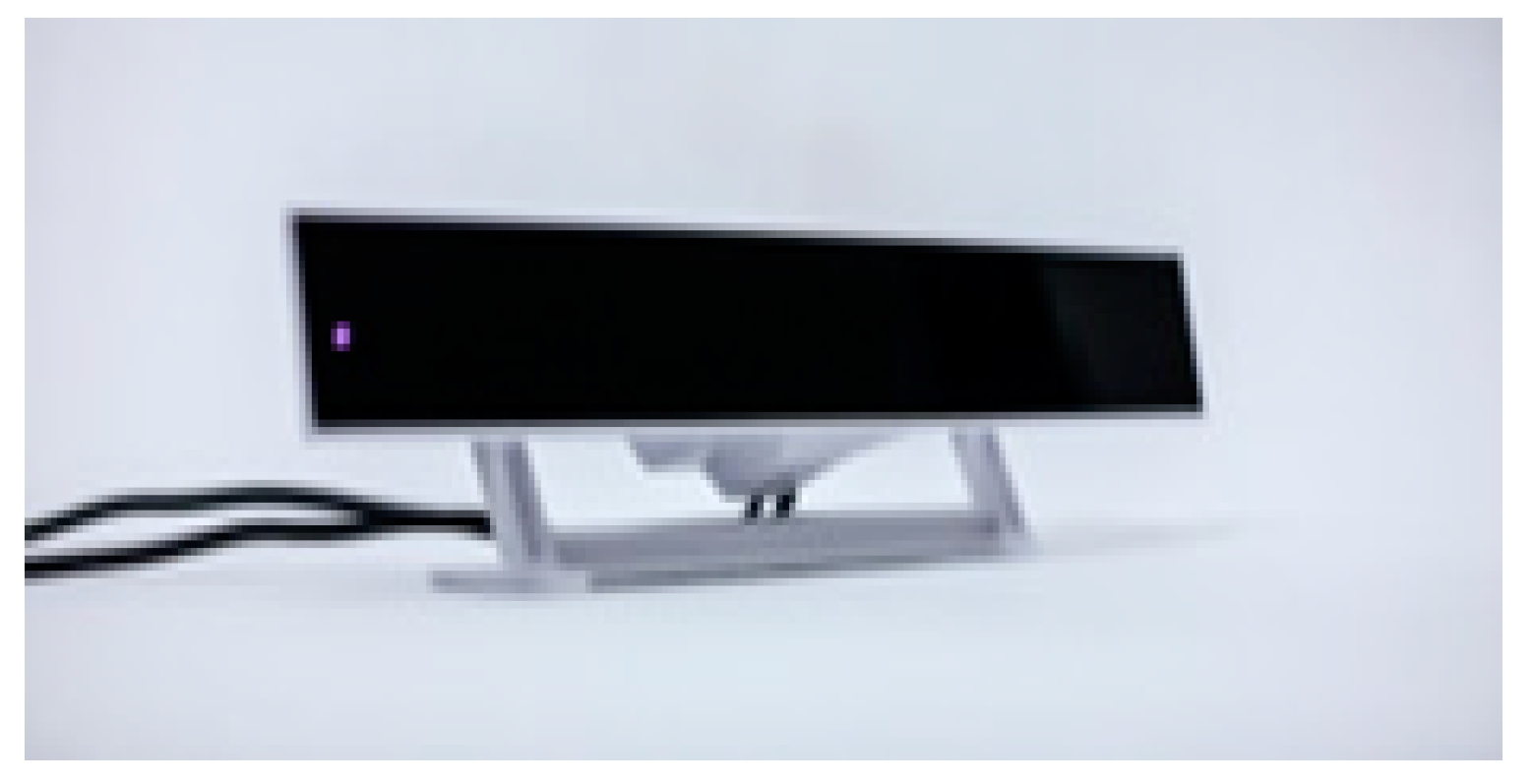
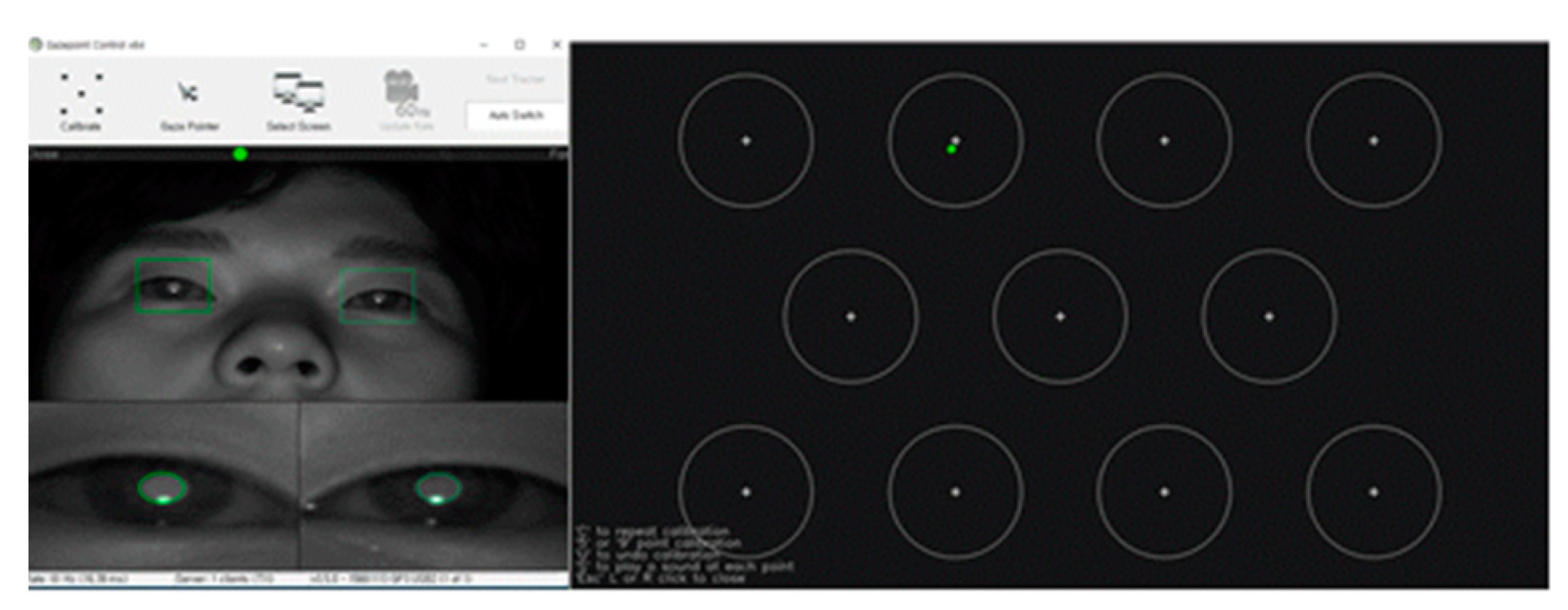

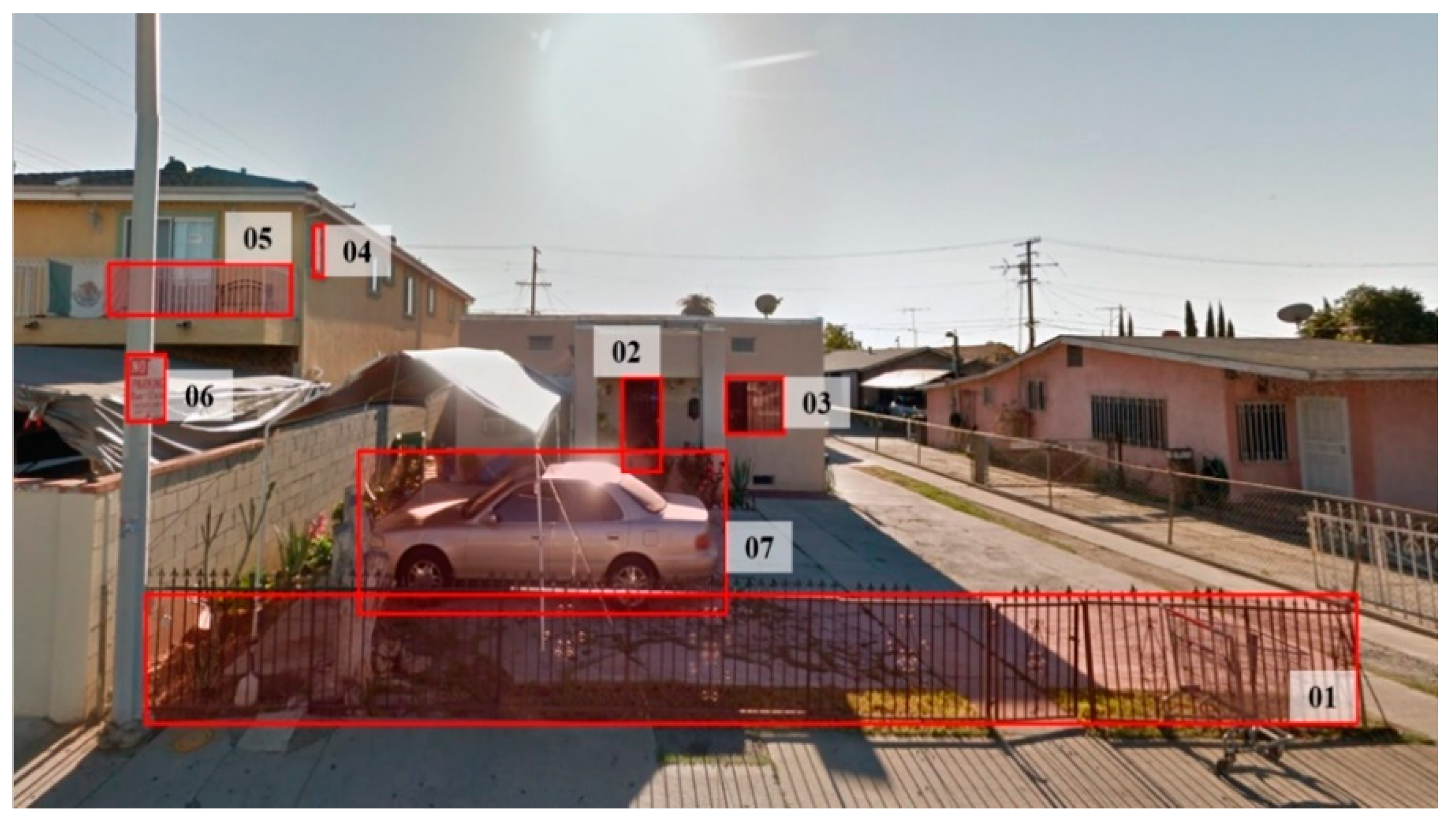



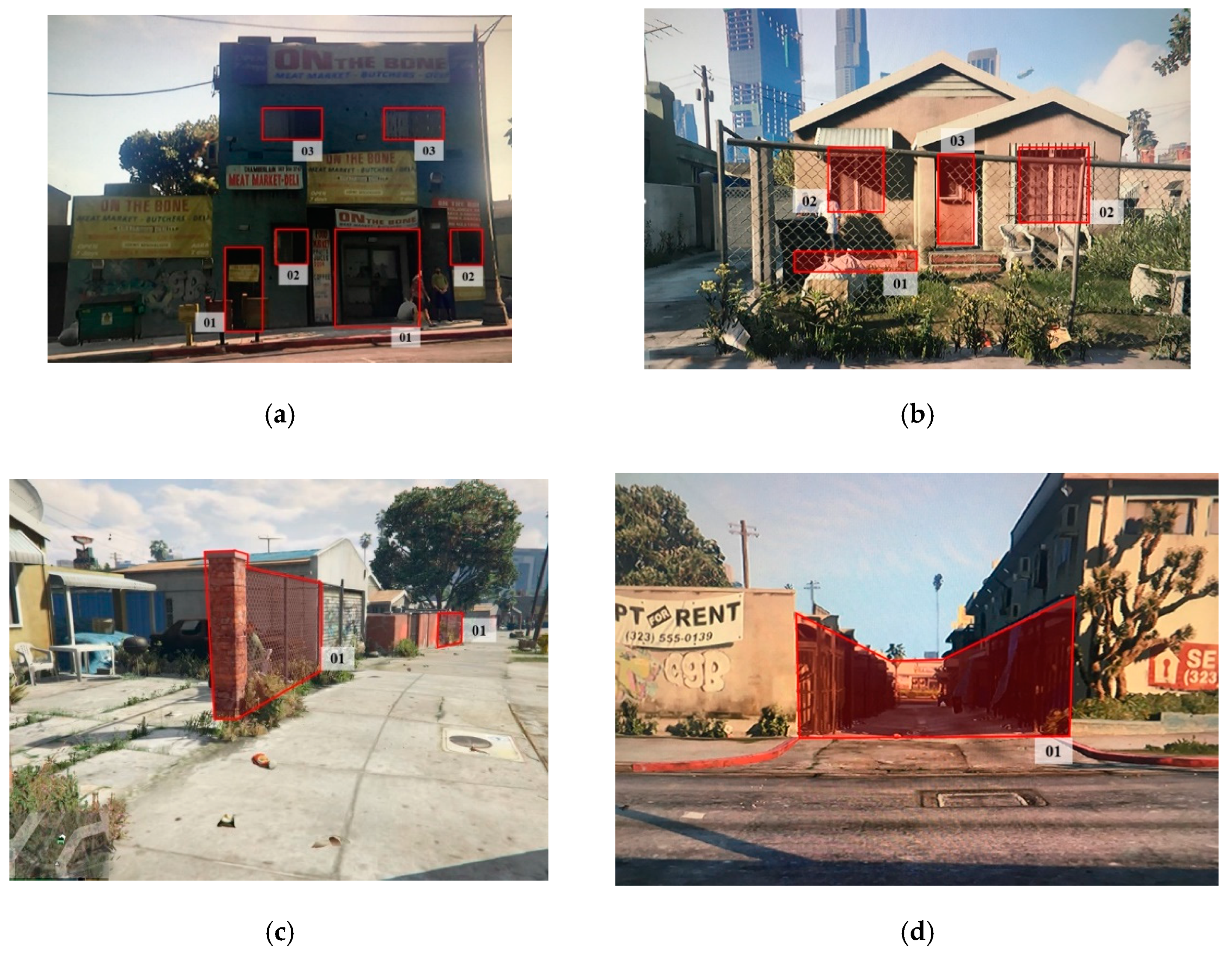
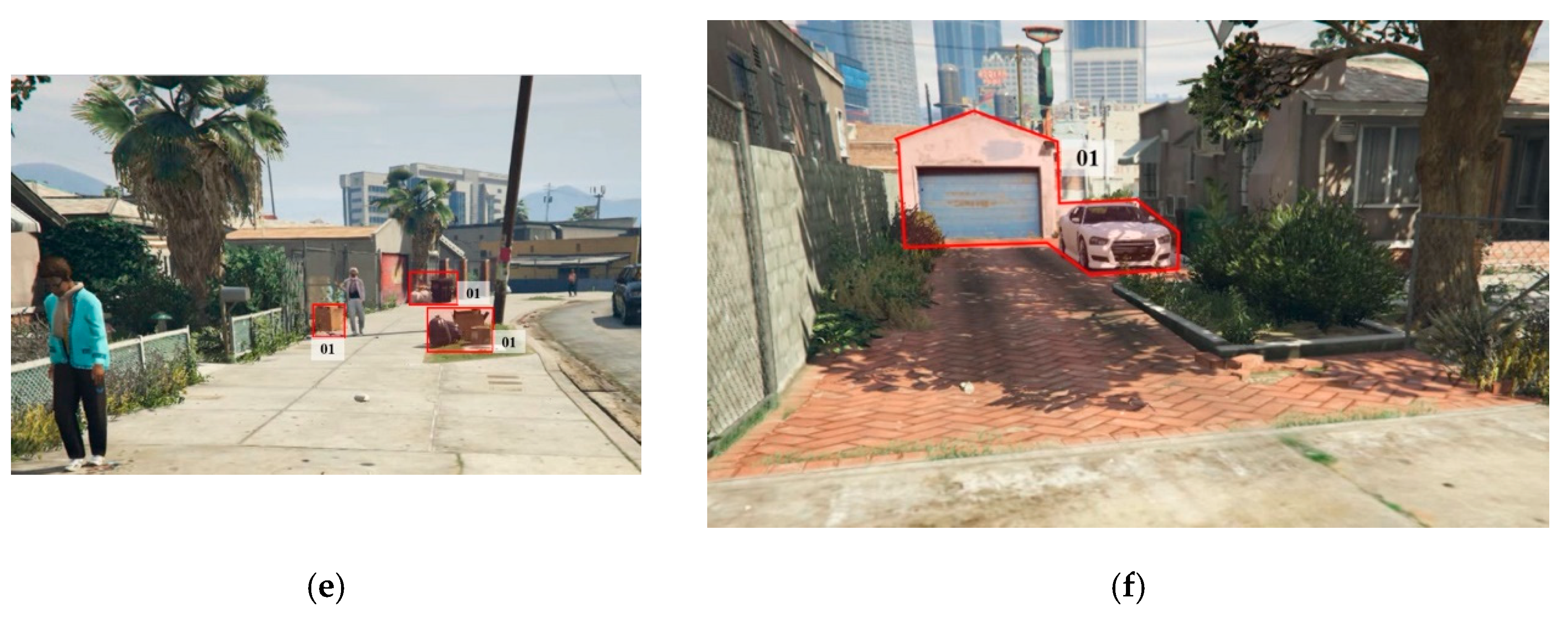
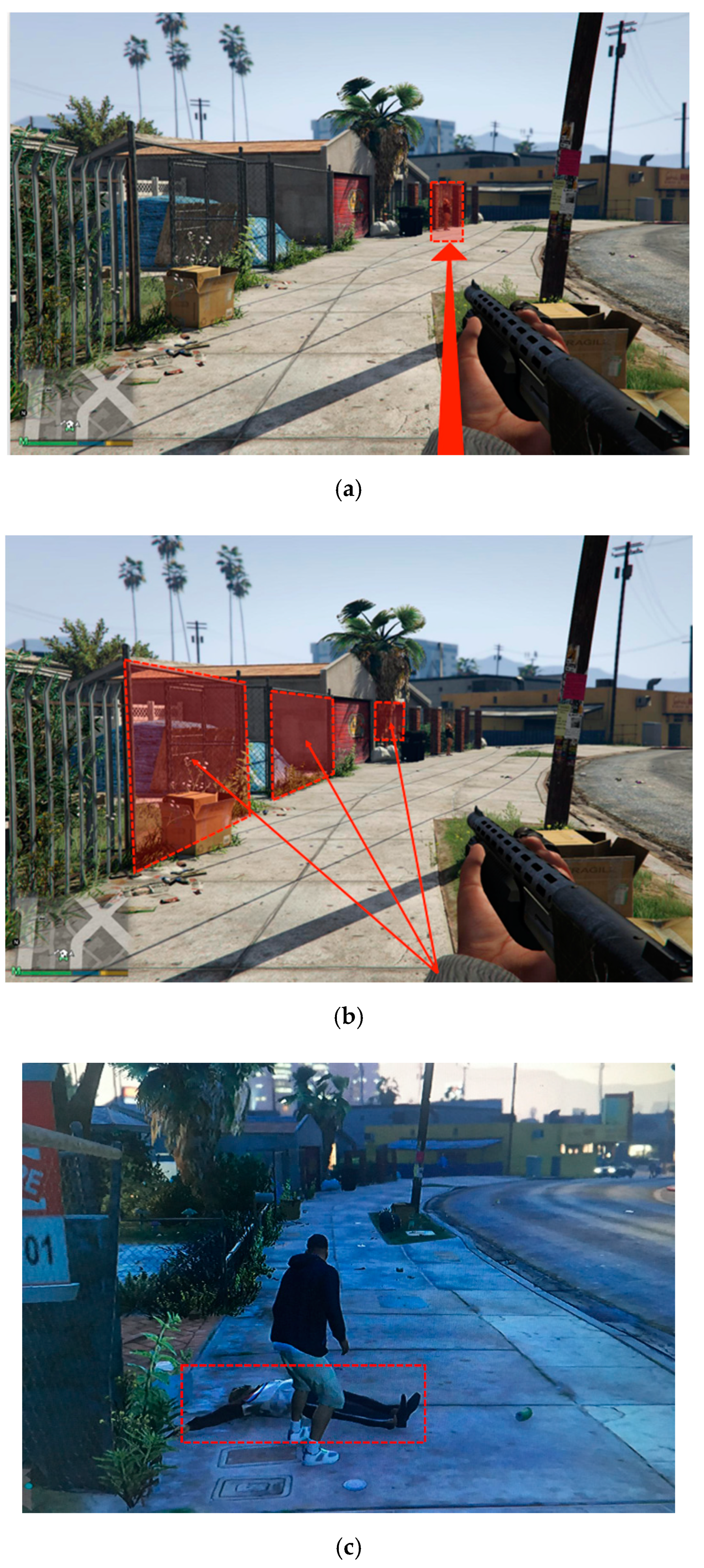
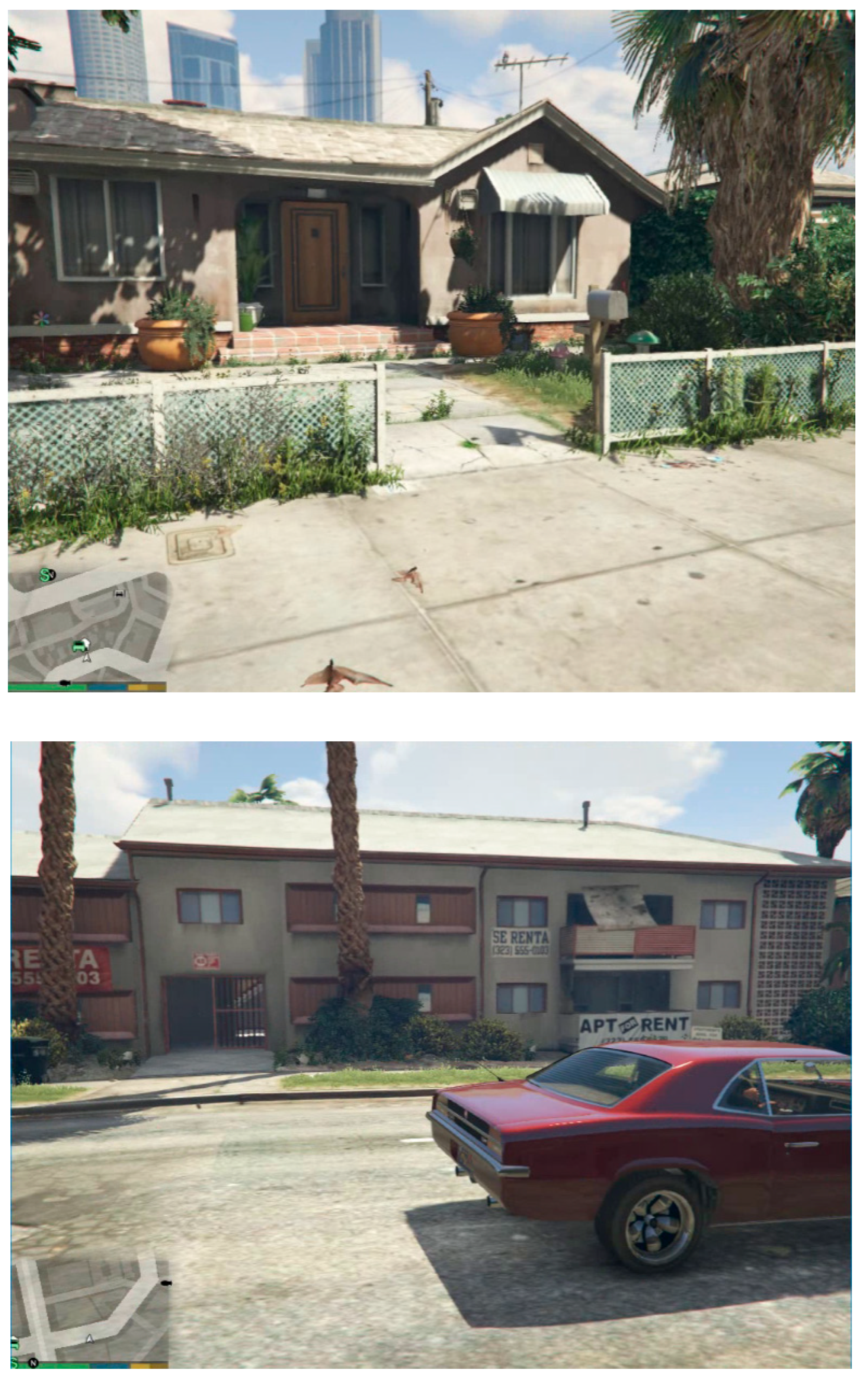
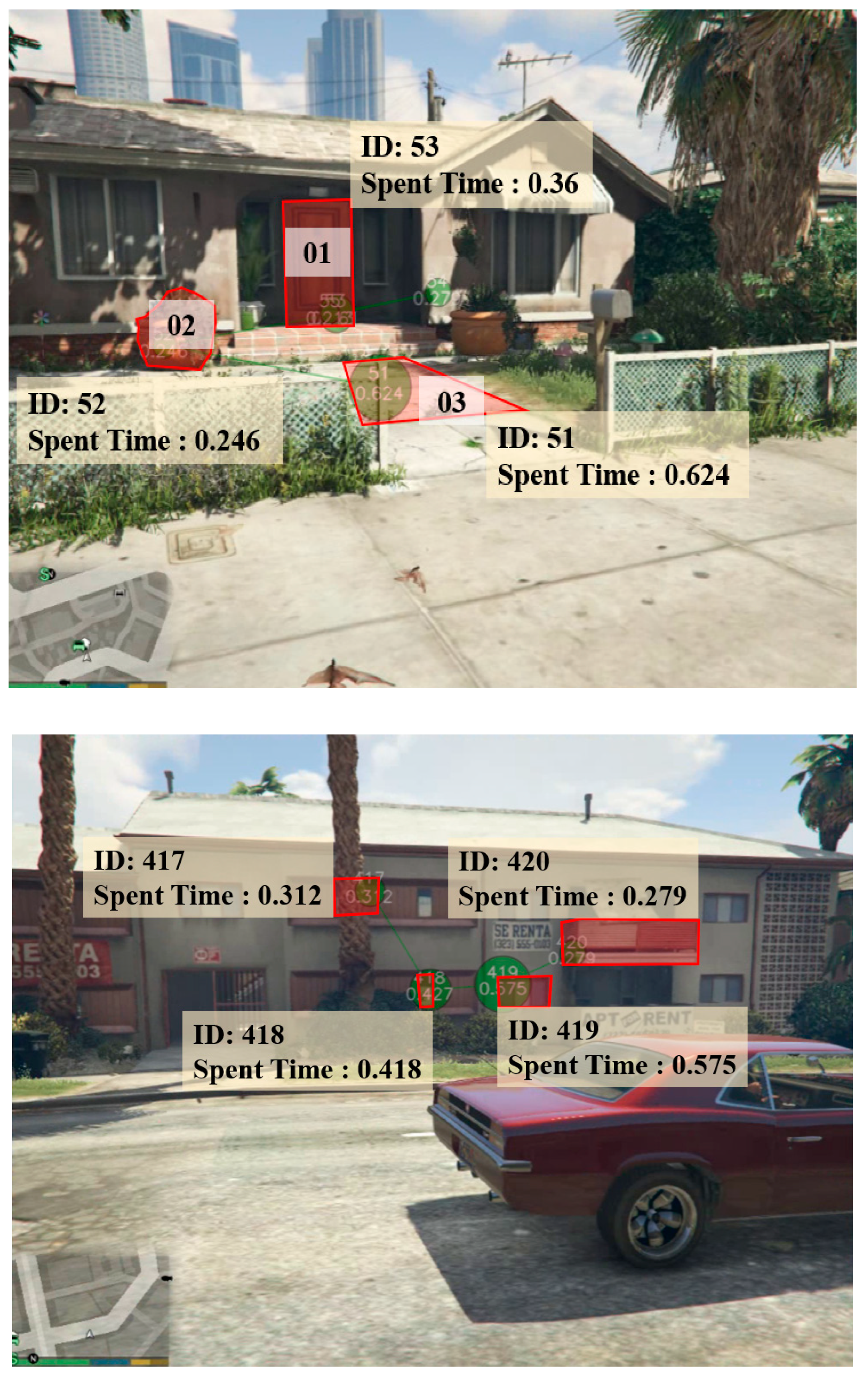

| Category | Factor | Definition |
|---|---|---|
| Criminal behavior | Rational choice | Street criminals decide on criminal intent after rationally considering the monetary advantages and disadvantages of committing the crime. |
| Ecological factors | The unpredictable behavior and mentality of criminals when committing the crime. Examples include impulsiveness, mistakes, ethical consciousness of criminal behavior, street culture, alcohol consumption, psychoactive substance abuse, collective behavior, and simple behavior [14]. | |
| Surrounding situation | Physical factors | Physical factors of the street environment that influence street criminal decision-making (CPTED). |
| Social factors | Social characteristics that influence criminal decision-making (e.g., population density, community, and racial diversity). | |
| Economic factors | Degree to which economic level influences street robbery decision-making. Most street criminals commit crimes for money and other valuables. | |
| Temporal factors | People’s behavioral patterns are affected by routine activities and relate to changes in time. The definition of the behavioral pattern is based on the temporal factors. |
| N | Min | Max | Mean | S.D. | |
|---|---|---|---|---|---|
| Age | 20 | 26 | 29 | 27.75 | 0.967 |
| Monthly allowance (KRW 10,000) | 20 | 30 | 100 | 58 | 20.673 |
| VR control proficiency | 20 | 6 | 10 | 7.55 | 1.356 |
| B | S.E. | Wals | Degree of Freedom | p-Value | Exp(B) | 95% Confidence Interval for Exp(b) | ||
|---|---|---|---|---|---|---|---|---|
| Min | Max | |||||||
| Monthly allowance | 0.487 | 0.313 | 2.417 | 1 | 0.120 | 1.627 | 0.881 | 3.005 |
| Constant | −1.298 | 1.139 | 1.299 | 1 | 0.254 | 0.273 | ||
| Control proficiency | 0.447 | 0.393 | 1.292 | 0.1 | 0.256 | 1.563 | 0.723 | 3.377 |
| Constant | −2.925 | 2.929 | 0.998 | 1 | 0.318 | 0.054 | ||
| Category | Components in VR | Type |
|---|---|---|
| Natural surveillance | NA1. Buildings with entrances exposed to the street (Eye-tracking data on buildings with entrances exposed to the street) | Continuous |
| NA2. Exposed balconies or verandas (Eye-tracking data on exposed balconies or verandas) | Continuous | |
| NA3. Windows exposed to the street (Eye-tracking data on windows visible from the street) | Continuous | |
| NA4. First-floor windows adjacent to the street (Eye-tracking data on windows adjacent to the street) | Continuous | |
| NA5. Visibility from main streets (Eye-tracking data on main street traffic) | Continuous | |
| NA6. Presence of a parking lot (Eye-tracking data on public parking lots) | Continuous | |
| Spatial structure | SS1. Alleys and open spaces (Eye-tracking data on alleys and open spaces) | Continuous |
| SS2. Presence of alleys near the crime scene (0 = Escape via the alleyway after committing crime; 1 = Escape through other means after committing crime) | Categorical | |
| Territoriality | TE1. Signs indicating private territory (e.g., signs and murals) | Continuous |
| TE2. Territoriality defined by see-through fences (Eye-tracking data on a territory’s interior via see-through fences) | Continuous | |
| Maintenance | MA1. Degree of maintenance of the street environment (Eye-tracking data on trash and incivilities) | Continuous |
| Variable | Description | Type |
|---|---|---|
| Time of fixation(s) | Amount of time the participant’s gaze remains fixated on an AOI during the experiment. | Scale |
| Time of fixation/Total experiment time | Ratio of time for fixation divided by the total experiment time; expressed as a ratio due to variation in experiment times. | Scale |
| Total number of fixations on AOI | Measures the number of times a participant’s gaze is fixed on a single AOI. | Scale |
| Total number of fixations on AOI/Total experiment time | Expressed as a ratio due to variation in experiment times. | Scale |
| Criminal decision-making | Decision to commit street robbery during the experiment (0 = criminal decision made; 1 = criminal decision not made). | Category |
| Crime detection | Detection after crime is committed (0 = detected; 1 = not detected). | Category |
| AOI Category | Ratio of Time Spent Time Spent/Total Experiment Time (Ratio A) | Ratio of Fixation Count Fixation Counts/Total Experiment Time (Ratio B) | Avg Ratio A/Avg Ratio B | ||
|---|---|---|---|---|---|
| Avg | SD | Avg | SD | ||
| NA1 | 0.055400 | 0.0139746 | 0.132920 | 0.0232209 | 0.416792 |
| NA2 | 0.029445 | 0.0072989 | 0.067315 | 0.1378660 | 0.437421 |
| NA3 | 0.050575 | 0.175920 | 0.133035 | 0.0474212 | 0.380163 |
| NA4 | 0.041840 | 0.0172831 | 0.106375 | 0.0432738 | 0.393325 |
| NA5 | 0.058360 | 0.287291 | 0.129150 | 0.0533004 | 0.451878 |
| NA6 | 0.014475 | 0.0075036 | 0.037320 | 0.0178688 | 0.387860 |
| SS1 | 0.055750 | 0.0256859 | 0.129150 | 0.0533004 | 0.431669 |
| TE1 | 0.091315 | 0.0286507 | 0.224065 | 0.0584841 | 0.407538 |
| TE2 | 0.073065 | 0.0188856 | 0.193940 | 0.0391037 | 0.376740 |
| MA1 | 0.050355 | 0.221380 | 0.123190 | 0.0539619 | 0.408759 |
| AOI Category Abbreviation | |||||
| NA1: Building with entrances exposed to the street. | NA6: Presence of alleys near the crime scene. | ||||
| NA2: Exposed balconies or verandas. | SS1: Alleys and open spaces. | ||||
| NA3: Windows exposed to the street. | TE1: Signs indicating private territory. | ||||
| NA4: First-floor windows adjacent to the street. | TE2: Territoriality defined by see-through fences. | ||||
| NA5: Visibility from main streets. | MA1: Degree of maintenance of the street environment. | ||||
| NA1 | NA2 | NA3 | NA4 | NA5 | NA6 | SS1 | TE1 | TE2 | MA1 | |
|---|---|---|---|---|---|---|---|---|---|---|
| NA1 | - | |||||||||
| NA2 | 0.872 ** | - | ||||||||
| NA3 | 0.920 ** | 0.683 ** | - | |||||||
| NA4 | 0.576 ** | 0.381 | 0.423 | - | ||||||
| NA5 | 0.865 ** | 0.773 ** | 0.889 ** | 0.144 | - | |||||
| NA6 | −0.137 | −0.315 | −0.059 | 0.234 | −0.448 | - | ||||
| SS1 | −0.390 | −0.586 ** | −0.131 | −0.588 ** | −0.185 | 0.432 | - | |||
| TE1 | 0.922 ** | 0.308 | 0.588 ** | −0.312 | 0.689 ** | 0.064 | 0.542 * | - | ||
| TE2 | 0.461 * | 0.749 ** | 0.900 ** | 0.699 ** | −0.517 * | −0.115 | −0.517 * | 0.197 | - | |
| MA1 | −0.778 ** | −0.466 * | −0.831 ** | −0.722 ** | −0.642 ** | 0.105 | 0.387 | −0.141 | −0.922 ** | - |
| AOI Category Abbreviation | ||||||||||
| NA1: Building with entrances exposed to the street. | NA6: Presence of alleys near the crime scene. | |||||||||
| NA2: Exposed balconies or verandas. | SS1: Alleys and open spaces. | |||||||||
| NA3: Windows exposed to the street. | TE1: Signs indicating private territory. | |||||||||
| NA4: First-floor windows adjacent to the street. | TE2: Territoriality defined by see-through fences. | |||||||||
| NA5: Visibility from main streets. | MA1: Degree of maintenance of the street environment. | |||||||||
| Chi-Square | Degree of Freedom | p-Value | |
|---|---|---|---|
| Hosmer–Lemeshow test | 3.901 | 3 | 0.272 |
| Observed Value | Prediction | ||||
|---|---|---|---|---|---|
| Crime Decision | Classification Accuracy % | ||||
| 0 | 1 | ||||
| Stage 1 | Crime decision | 0 | 6 | 2 | 75.0 |
| 1 | 3 | 9 | 75.0 | ||
| Total percentage | 75.0 | ||||
| B | S.E. | Wals | Degree of Freedom | p-Value | Exp(B) | 95% Confidence Interval for EXP(B) | ||
|---|---|---|---|---|---|---|---|---|
| Min | Max | |||||||
| NA2 | 0.558 | 0.268 | 4.128 | 1 | 0.037 | 1.747 | 1.033 | 2.954 |
| NA3 | 0.525 | 0.259 | 4.102 | 1 | 0.043 | 1.691 | 1.017 | 2.812 |
| NA4 | 1.613 | 0.768 | 4.408 | 1 | 0.036 | 5.019 | 1.113 | 22.627 |
| NA6 | 0.267 | 0.211 | 1.603 | 1 | 0.205 | 1.306 | 0.864 | 1.973 |
| SS1 | 0.266 | 0.192 | 1.914 | 1 | 0.167 | 1.305 | 0.895 | 1.902 |
| TE1 | 0.700 | 0.267 | 6.857 | 1 | 0.009 | 2.013 | 1.192 | 3.400 |
| Constant term | −1.416 | 0.932 | 2.304 | 1 | 0.129 | 0.243 | ||
| AOI Category Abbreviation | ||||||||
| NA1: Building with entrances exposed to the street. | NA6: Presence of alleys near the crime scene. | |||||||
| NA2: Exposed balconies or verandas. | SS1: Alleys and open spaces. | |||||||
| NA3: Windows exposed to the street. | TE1: Signs indicating private territory. | |||||||
| NA4: First-floor windows adjacent to the street. | TE2: Territoriality defined by see-through fences. | |||||||
| NA5: Visibility from main streets. | MA1: Degree of maintenance of the street environment. | |||||||
© 2020 by the authors. Licensee MDPI, Basel, Switzerland. This article is an open access article distributed under the terms and conditions of the Creative Commons Attribution (CC BY) license (http://creativecommons.org/licenses/by/4.0/).
Share and Cite
Yang, J.w.; Kim, D.; Jung, S. Using Eye-Tracking Technology to Measure Environmental Factors Affecting Street Robbery Decision-Making in Virtual Environments. Sustainability 2020, 12, 7419. https://doi.org/10.3390/su12187419
Yang Jw, Kim D, Jung S. Using Eye-Tracking Technology to Measure Environmental Factors Affecting Street Robbery Decision-Making in Virtual Environments. Sustainability. 2020; 12(18):7419. https://doi.org/10.3390/su12187419
Chicago/Turabian StyleYang, Jae weon, Dowoo Kim, and Sungwon Jung. 2020. "Using Eye-Tracking Technology to Measure Environmental Factors Affecting Street Robbery Decision-Making in Virtual Environments" Sustainability 12, no. 18: 7419. https://doi.org/10.3390/su12187419
APA StyleYang, J. w., Kim, D., & Jung, S. (2020). Using Eye-Tracking Technology to Measure Environmental Factors Affecting Street Robbery Decision-Making in Virtual Environments. Sustainability, 12(18), 7419. https://doi.org/10.3390/su12187419




